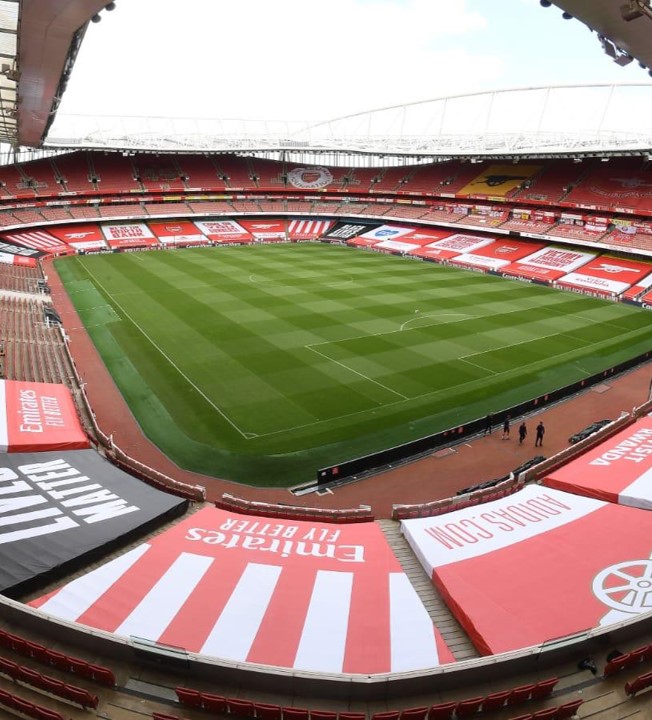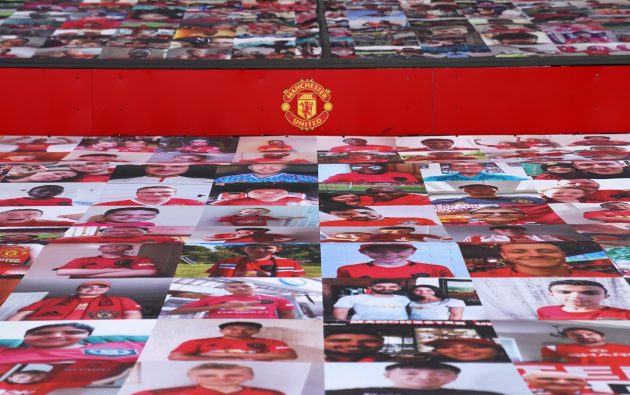Cover story: How the Premier League ‘wrapped’ every stadium and hid the empty seats

Football fans will by now be familiar with Premier League “stadium wraps” or “seat kills”, even if they don’t recognise the terminology.
The vast seat coverings, typically emblazoned with club colours and slogans, have provided a backdrop to the action since English football returned to empty grounds in June.
But who makes these displays and what are they made of? Who decides what the stadium dressing looks like? And how and why were they put in place?
The answers lie in a story more than 70 years in the making, which draws on the work of hundreds of people and used enough material to cover the whole of Green Park.
This is the definitive guide to dressing a Premier League stadium.
Who makes the seat covers?
Like many people, Andrew Hodson started to get a little concerned in March.
Hodson is head of sport partnerships at CSM Live, a division of one of the biggest sports and entertainment agencies.
CSM Live specialises in creating the look and feel of events, mainly by designing and producing signage.
The company made all the public-facing visuals for the London 2012 Olympics, and was due to dress football’s Euro 2020 last summer.
The business became part of CSM in 2011 but dates back to the 1940s. It went from making signs for motor racing to advertising boards at football and now does a broad range of work.
CSM also has retail clients, such as Lidl, which it helps to stage events.
But all that changed in March as the spread of Covid-19 led to lockdown.
“Overnight there was no sport, no shops open. Nothing,” says Hodson. “For us, that was quite scary. Many of the people who we do business with had basically shut down and like so many others our live events business was dramatically affected.”
How CSM Live got the job
Hodson set about trying to drum up some work, even though, as part of the well-resourced CSM, the business was not in immediate danger.
“Like a lot of companies, we started rattling a few cages. Talking to people we might not have spoken to for a long time,” he says.
In time, that led to talks with the Premier League. This was April or May, Hodson recalls, and the conversation was about what would happen when football restarted.
It transpired that the league wanted to dress stadiums, and with a degree of consistency. The effect would both cover empty seats but also minimise echo.
CSM’s experience, and the fact that they could design and produce materials in-house, made them well suited to the job.
Hodson says: “We had to draw up a plan of action so that we were ready to go as soon as we were given the green light.”
What are the seat covers made of and who designs them?
Seat kills may be unfamiliar in the Premier League, but they are nothing new.
They are a way of blocking out an area of seating when a stadium needs to be reconfigured for a specific event. CSM Live has done this for NFL games at Wembley, for instance.
Material — in this case a perforated fabric so that it doesn’t sag when wet — is stretched across areas of seating and attached using cable ties.
The difference with this Premier League contract is that the areas of seating to be covered are vast.
As a minimum, clubs must cover their lower tiers — whatever is visible from the main TV camera angle — on all four sides of the stadium. Some teams have paid extra to dress upper tiers too.

Clubs decide how their displays look, but there are fixed proportions allocated to club messaging (65 per cent), sponsors (25) and Premier League branding (10).
Teams typically opt for their badges, club mottos and song lyrics. Manchester United and Wolves also incorporated mosaic-effect collages fans and players, respectively.
United were even accused of misattributing a quote — “Football is nothing without fans” — to their former manager Sir Matt Busby on one of their displays.
Even something as seemingly benign as seat covers can bring out the tribalism in football.
How the stadiums were dressed
For Hodson and CSM Live, dressing the stadiums in time for the return of Premier League football in June represented a complex logistical operation.
One of the first jobs was to dispatch staff to measure up and photograph all 20 grounds, from Bournemouth to Newcastle — no easy task during lockdown.
That allowed CSM Live to draw up seating plans and, alongside the Premier League, create templates for each team.
Clubs then submitted their designs or collaborated with CSM Live’s studio to create the artwork.
Later in May, the green light to begin production came and the countdown commenced.
“We had something like three weeks to turn the whole thing around once we were officially told we could go ahead,” says Hodson.
CSM Live began production, printing “hundreds of thousands of square metres of material,” says Hodson.

The next task was to devise a schedule of shipping and installation so that each ground would be ready for its first fixture.
Because not every team played at home in their first fixture after the Covid-19 interruption, that meant staggering visits to apply the stadium wraps.
“You couldn’t possibly do everything on one day. There’s not a company in the world who could do that,” Hodson adds.
“It was phasing it so that it would conclude one or two days before the first game in each venue, then move onto the next one.”
Local teams carried out the installations, in teams of six to 12 depending on the venue size and timeframe. More than 100 people worked on the project, he estimates.
Printing until the 11th hour
Sometimes CSM Live were left sweating as clubs, some under-staffed due to the furlough scheme, left it late to supply their designs.
“Getting sign-off was probably the main challenge,” Hodson says. “It means you’re printing right up until that 11th hour. And then delivering almost as the installation is going on.”
But decades of experience paid off. “We’re used to that challenge and we deal with it,” he says.
Seat coverings had to be changed for the new season to accommodate new clubs and their stadiums, as well as new sponsors.
A solution that was only intended for a few months has lasted far longer, although vaccine developments mean fans may return in early 2021..
And as sport picks up again, so will CSM Live’s workflow likely increase. For now, Hodson can take satisfaction from what they delivered — and one tribute in particular.
“It went down extremely well,” he says. “The clubs loved it. I’m not saying it was without challenges, but we made every deadline. And I think even Gary Lineker made some nice noises about the work when the first games were broadcast on the BBC.”
